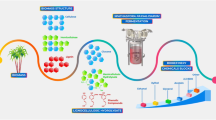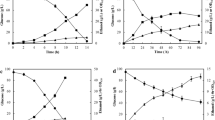Abstract
Industrial fermentation of lignocellulosic hydrolysates to ethanol requires microorganisms able to utilise a broad range of carbon sources and generate ethanol at high yield and productivity. D. bruxellensis has recently been reported to contaminate commercial ethanol processes, where it competes with Saccharomyces cerevisiae [4, 26]. In this work Brettanomyces/Dekkera yeasts were studied to explore their potential to produce ethanol from renewable sources under conditions suitable for industrial processes, such as oxygen-limited and low-pH conditions. Over 50 strains were analysed for their ability to utilise a variety of carbon sources, and some strains grew on cellobiose and pentoses. Two strains of D. bruxellensis were able to produce ethanol at high yield (0.44 g g−1 glucose), comparable to those reported for S. cerevisiae. B. naardenensis was shown to be able to produce ethanol from xylose. To obtain ethanol from synthetic lignocellulosic hydrolysates we developed a two-step fermentation strategy: the first step under aerobic conditions for fast production of biomass from mixtures of hexoses and pentoses, followed by a second step under oxygen limitation to promote ethanol production. Under these conditions we obtained biomass and ethanol production on synthetic lignocellulosic hydrolysates, with ethanol yields ranging from 0.2 to 0.3 g g−1 sugar. Hexoses, xylose and arabinose were consumed at the end of the process, resulting in 13 g l−1 of ethanol, even in the presence of furfural. Our studies showed that Brettanomyces/Dekkera yeasts have clear potential for further development for industrial processes aimed at production of ethanol from renewable sources.


Similar content being viewed by others
References
Agbogbo F, Coward-Kelly G, Torry-Smith M, Wenger K, Jeffries TW (2007) The effect of initial cell concentration on xylose fermentation by Pichia stipitis. Appl Biochem Biotechnol 137:653–662
Aguillar Uscanga MG, Delia M-L, Strehaiano P (2003) Brettanomyces bruxellensis: effect of oxygen on growth and acetic acid production. Appl Microbiol Biotechnol 61:157–162
André L, Hemming A, Adler L (1991) Studies on the osmotic induction of glycerol production and glycerol 3-phosphate dehydrogenase (NAD+). FEBS 286:13–17
de Souza Liberal AT, Basílio ACM, do Monte Resende A, Brasileiro BTV, da Silva-Filho EA, de Morais JOF, Simões DA, de Morais MA Jr (2007) Identification of Dekkera bruxellensis as a major contaminant yeast in continuous fuel ethanol fermentation. J Appl Microbiol 102:538–547
du Preez JC, Prior BA, Monteiro AMT (1984) The effect of aeration on xylose fermentation by Candida shehatae and Pachysolen tannophilus. Appl Microbiol Biotechnol 19:261–266
Fugelsang KC (1996) Wine microbiology. Chapman & Hall, New York
Hahn-Hägerdal B, Jeppsson H, Olsson L, Mohagheghi A (1994) An interlaboratory comparison of the performance of ethanol-producing micro-organisms in a xylose-rich acid hydrolysate. Appl Microbiol Biotechnol 41:62–72
Hahn-Hägerdal B, Karhumaa K, Fonseca C, Spencer-Martins I, Gorwa-Grauslund MF (2007) Towards industrial pentose-fermenting yeast strains. Appl Microbiol Biotechnol 74:937–953
Hayn M, Steiner W, Klinger R, Steinmuller H, Sinner M, Esterbrauer H (1993) Basic research and pilot studies on the enzymatic conversion of lignocellulosics. In: Saddler JN (ed) Bioconversion of forest and agricultural plant residues. CAB International, Wallingford, UK, pp 33–72
Hellborg L, Piskur J (2009) Complex nature of the genome in a wine spoilage yeast, Dekkera bruxellensis. Eukaryot Cell 8:1739–1749
Huang C-F, Lin T-H, Guo G-L, Hwang W-S (2009) Enhanced ethanol production by fermentation of rice straw hydrolysate without detoxification using a newly adapted strain of Pichia stipitis. Bioresour Technol 100:3914–3920
Jeffries TW, Grigoriev IV, Grimwood J, Laplaza JM, Aerts A, Salamov A, Schmutz J, Lindquist E, Dehal P, Shapiro H, Jin Y-S, Passoth V, Richardson PM (2007) Genome sequence of the lignocellulosie-bioconverting and xylose-fermenting yeast Pichia stipitis. Nature Biotechnol 25:319–326
Jin YS, Jeffries TW (2004) Stoichiometric network constraints on xylose metabolism by recombinant Saccharomyces cerevisiae. Metab Eng 6:229–238
Karhumaa K, Wiedemann B, Boles E, Hahn-Hägerdal B, Gorwa-Grauslund MF (2006) Co-utilization of L-arabinose and D-xylose by laboratory and industrial Saccharomyces cerevisiae strains. Microb Cell Fact 5:18–24
Karhumaa K, Sanchez RG, Hahn-Hägerdal B, Gorwa-Grauslund MF (2007) Comparison of the xylose reductase-xylitol dehydrogenase and the xylose isomerase pathways for xylose fermentation by recombinant Saccharomyces cerevisiae. Microb Cell Fact 6:5
Kotter P, Ciriacy M (1993) Xylose fermentation by Saccharomyces cerevisiae. Appl Microbiol Biotechnol 38:776–783
Kurtzman CP, Robnett CJ (1998) Identification and phylogeny of ascomycetous yeasts from analysis of nuclear large subunit (26S) ribosomal DNA partial sequences. Antonie Van Leeuwenhoek 73:331–371
Kuyper M, Toirkens MJ, Diderich JA, Winkler AA, van Dijken JP, Pronk JT (2005) Evolutionary engineering of mixed-sugar utilization by a xylose-fermenting Saccharomyces cerevisiae strain. FEMS Yeast Res 5:925–934
Kuyper M, Hartog MM, Toirkens MJ, Almering MJ, Winkler AA, van Dijken JP, Pronk JT (2005) Metabolic engineering of a xylose-isomerase-expressing Saccharomyces cerevisiae strain for rapid anaerobic xylose fermentation. FEMS Yeast Res 5:399–409
Larsson S, Cassland P, Jönsson LJ (2001) Development of a Saccharomyces cerevisiae strain with enhanced resistance to phenolic fermentation inhibitors in lignocellulose hydrolysates by heterologous expression of laccase. Appl Environ Microbiol 63:1163–1170
Öhgren K, Bengtsson O, Gorwa-Grauslund MF, Galbe M, Hahn-Hägerdal B, Zacchi G (2006) Simultaneous saccharification and co-fermentation of glucose and xylose in steam-pretreated corn stover at high fiber content with Saccharomyces cerevisiae TMB3400. J Biotechnol 126:448–498
Olsson L, Soerensen HR, Dam PB, Christiensen H, Krogh KM, Meyer AS (2006) Separate and simultaneous enzymatic hydrolysis and fermentation of wheat hemicellulose with recombinant xylose utilizing Saccharomyces cerevisiae. Appl Biochem Biotechnol 133:117–129
Palmqvist E, Hahn-Hägerdal B (2000) Fermentation of lignocellulosic hydrolysates I: inhibition and detoxification. Bioresour Technol 74:17–24
Palmqvist E, Hahn-Hägerdal B (2000) Fermentation of lignocellulosic hydrolysates II: inhibitors and mechanisms of inhibition. Bioresour Technol 74:25–33
Parekh SR, Parekh RS, Wayman M (1988) Fermentation of xylose and cellobiose by Pichia stipitis and Brettanomyces clausenii. Appl Biochem Biotechnol 18:325
Passoth V, Blomqvist J, Schnürer J (2007) Dekkera bruxellensis and Lactobacillus vini from a stable ethanol-producing consortium in a commercial alcohol process. Appl Environ Microbiol 73:4354–4356
Perego P, Converti A, Palazzi E, Del Borghi M, Ferraiolo G (1990) Fermentation of hardwood hemicellulose hydrolysate by Pachysolen tannophilus, Candida shehatae and Pichia stipitis. J Ind Microbiol 6:157–164
Postma E, Verduyn C, Scheffers WA, van Dijken JP (1989) Enzymatic analysis of the Crabtree effect in glucose-limited chemostat cultures of Saccharomyces cerevisiae. Appl Env Microbiol 55:468–477
Sonderegger M, Jeppsson M, Hahn-Hagerdal B, Sauer U (2004) Molecular basis for anaerobic growth of Saccharomyces cerevisiae on xylose, investigated by global gene expression and metabolic flux analysis. Appl Env Microbiol 70:2307–2317
Skoog K, Hahn-Hägerdal B (1990) Effect of oxygenation on xylose fermentation by Pichia stipitis. Appl Environ Microbiol 56:3389–3394
Van Dijken JP, Scheffers WA (1986) Redox balances in the metabolism of sugars by yeasts. FEMS Microbiol Rev 32:199–224
Van Vleet JH, Jeffries TW (2009) Yeast metabolic engineering for hemicellulosic ethanol production. Curr Opin Biotechnol 20:300–306
Verduyn C, Postma E, Scheffers WA, van Dijken JP (1992) Effect of benzoic acid on metabolic fluxes in yeast: a continuous-culture study on the regulation of respiration and alcoholic fermentation. Yeast 8:501–517
Toivola A, Yarrow D, van den Bosch BE, van Dijken JP, Scheffers WA (1984) Alcoholic fermentation of D-xylose by yeasts. Appl Env Microbiol 47:1221–1223
Zeeman A-M, Kuyper M, Pronk JT, van Dijken JP, Steensma HY (2000) Regulation of pyruvate metabolism in chemostat cultures of Kluyveromyces lactis CBS 2359. Yeast 16:611–620
Wahlbom CF, van Zyl WH, Jönsson LJ, Hahn-Hägerdal B, Cordero Otero RR (2003) Generation of the improved recombinant xylose-utilizing Saccharomyces cerevisiae TMB 3400 by random mutagenesis and physiological comparison with Pichia stipitis CBS 6054. FEMS Yeast Res 3:319–326
Woolfit M, Rozpedowska E, Piskur J, Wolfe KH (2007) Genome survey sequencing of the wine spoilage yeast Dekkera (Brettanomyces) bruxellensis. Eukaryot Cell 6(4):721–733
Acknowledgments
This work was partially funded by INTAS (ref. no. 05-1000005-7730) to C.C. and J.P. J.P. and L.H. thank the Futura and Tryggers Foundation for their funding support.
Author information
Authors and Affiliations
Corresponding author
Rights and permissions
About this article
Cite this article
Galafassi, S., Merico, A., Pizza, F. et al. Dekkera/Brettanomyces yeasts for ethanol production from renewable sources under oxygen-limited and low-pH conditions. J Ind Microbiol Biotechnol 38, 1079–1088 (2011). https://doi.org/10.1007/s10295-010-0885-4
Received:
Accepted:
Published:
Issue Date:
DOI: https://doi.org/10.1007/s10295-010-0885-4




